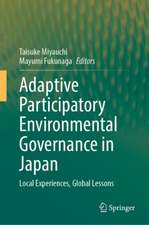China’s Grain for Green Program: A Review of the Largest Ecological Restoration and Rural Development Program in the World
Autor Claudio O. Delang, Zhen Yuanen Limba Engleză Hardback – 18 noi 2014
The book is organised in three sections. Part One reviews the history of land management in China from 1949 to 1998, exploring the conditions that led to the introduction of GfG, and comparing it to other reforestation programs. Part Two offers an overview of GfG, describing the timeline of the program, compensation paid to farmers, the rules concerning land and plant selection, the extent to which these rules were followed, the attitudes of farmers towards the program, and the way in which the program is organized and implemented by various state actors. Part Three discusses the impact of the GfG, from both ecological and socio-economic standpoints, looking at the economic benefits that result from participating in the GfG, the impact of the GfG across local economies, the redistribution of the labor force and the sustainability of the program, in particular the question of what will happen to the converted land when payments to farmers end.
| Toate formatele și edițiile | Preț | Express |
|---|---|---|
| Paperback (1) | 638.24 lei 6-8 săpt. | |
| Springer International Publishing – 23 aug 2016 | 638.24 lei 6-8 săpt. | |
| Hardback (1) | 644.49 lei 6-8 săpt. | |
| Springer International Publishing – 18 noi 2014 | 644.49 lei 6-8 săpt. |
Preț: 644.49 lei
Preț vechi: 758.23 lei
-15% Nou
Puncte Express: 967
Preț estimativ în valută:
123.32€ • 128.76$ • 102.07£
123.32€ • 128.76$ • 102.07£
Carte tipărită la comandă
Livrare economică 05-19 aprilie
Preluare comenzi: 021 569.72.76
Specificații
ISBN-13: 9783319115047
ISBN-10: 3319115049
Pagini: 200
Ilustrații: XX, 230 p. 40 illus., 7 illus. in color.
Dimensiuni: 155 x 235 x 20 mm
Greutate: 0.53 kg
Ediția:2015
Editura: Springer International Publishing
Colecția Springer
Locul publicării:Cham, Switzerland
ISBN-10: 3319115049
Pagini: 200
Ilustrații: XX, 230 p. 40 illus., 7 illus. in color.
Dimensiuni: 155 x 235 x 20 mm
Greutate: 0.53 kg
Ediția:2015
Editura: Springer International Publishing
Colecția Springer
Locul publicării:Cham, Switzerland
Public țintă
ResearchCuprins
Part 1: Why the Grain for Green program?.- Chapter 1 Management of forest resources from 1949 to 1998.- Chapter 2 China’s reforestation and rural development programs.- Part 2: Overview of the Grain for Green program.- Chapter 3 Program timeline.- Chapter 4 Farmers’ compensation.- Chapter 5 Land selection.- Chapter 6 Plant selection.- Chapter 7 Household selection, participation and attitudes.- Chapter 8 Planning and implementation.- Part 3: The impact of the Grain for Green program.- Chapter 9 Ecological and environmental impact.- Chapter 10 Impact on grain market and price.- Chapter 11 Participants’ income levels.- Chapter 12 Labor force redistribution.- Chapter 13 Sustainability of the Grain for Green program.- References.
Textul de pe ultima copertă
This book provides a comprehensive review of Grain for Green, China’s nationwide program which pays farmers to revert sloping or marginal farm land to trees or grass. The program aims to improve the ecological conditions of much of China, and the socioeconomic circumstances of hundreds of millions of people. GfG is the largest reforestation, ecological restoration, and rural development initiative in history, combining the biggest investment, the greatest involvement, and the broadest degree of public participation ever.
The book is organised in three sections. Part One reviews the history of land management in China from 1949 to 1998, exploring the conditions that led to the introduction of GfG, and comparing it to other reforestation programs. Part Two offers an overview of GfG, describing the timeline of the program, compensation paid to farmers, the rules concerning land and plant selection, the extent to which these rules were followed, the attitudes of farmers towards the program, and the way in which the program is organized and implemented by various state actors. Part Three discusses the impact of the GfG, from both ecological and socio-economic standpoints, looking at the economic benefits that result from participating in the GfG, the impact of the GfG across local economies, the redistribution of the labor force and the sustainability of the program, in particular the question of what will happen to the converted land when payments to farmers end.
The book is organised in three sections. Part One reviews the history of land management in China from 1949 to 1998, exploring the conditions that led to the introduction of GfG, and comparing it to other reforestation programs. Part Two offers an overview of GfG, describing the timeline of the program, compensation paid to farmers, the rules concerning land and plant selection, the extent to which these rules were followed, the attitudes of farmers towards the program, and the way in which the program is organized and implemented by various state actors. Part Three discusses the impact of the GfG, from both ecological and socio-economic standpoints, looking at the economic benefits that result from participating in the GfG, the impact of the GfG across local economies, the redistribution of the labor force and the sustainability of the program, in particular the question of what will happen to the converted land when payments to farmers end.
Caracteristici
Presents the first multidisciplinary examination of the Grain for Green program Offers an integrated approach linking social, economic, institutional, and ecological factors Reviews and analyzes the ecological and socio-economic consequences of Grain for Green, as well as the program's sustainability Includes supplementary material: sn.pub/extras






















